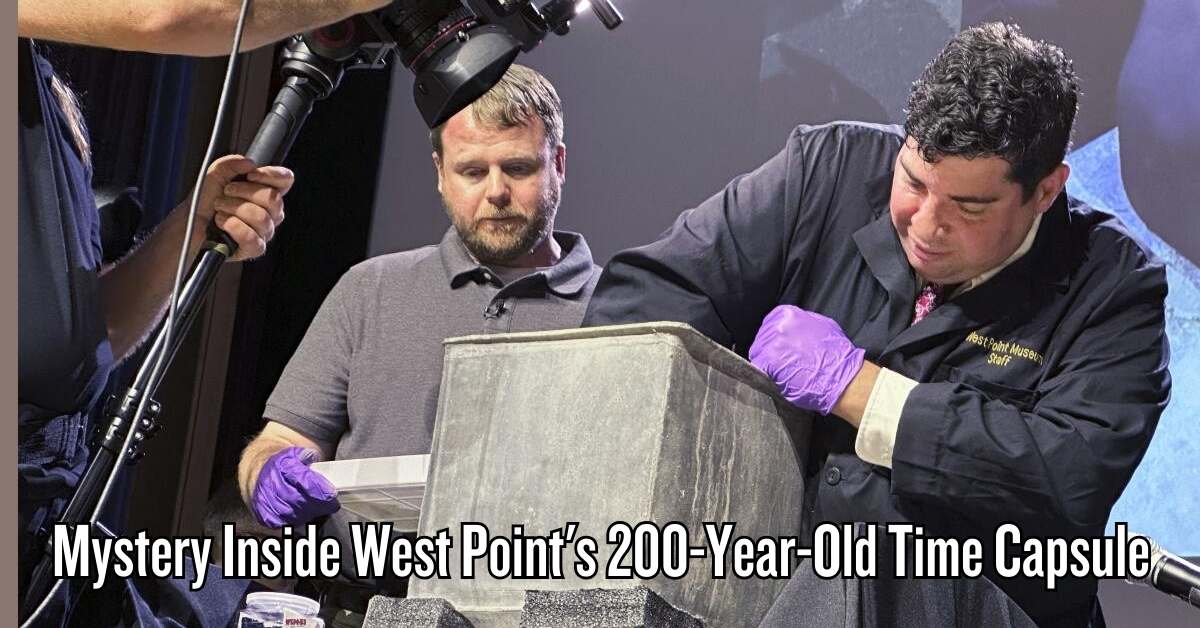In a thrilling twist of history, a nearly 200-year-old time capsule discovered at the US Military Academy has turned out to be far from empty. This revelation promises to shed light on the intriguing legacy of the Academy’s famed grounds, offering a stark contrast to the unforgettable moment when Geraldo Rivera opened Al Capone’s famously vacant vault on live TV back in 1986.
The anticipation was palpable as West Point Superintendent Lieutenant General Steven Gilland humorously alluded to the empty Capone vault just moments before the enigmatic box was finally opened in front of a captivated audience in a packed campus auditorium.
Inside the super-strong lead container, which had even defied detailed X-ray examinations, lay a surprising assortment of silt, broken materials that defied easy identification, and an initial from an unknown maker. But the experts at the academy were not ready to give up just yet.
This time capsule, West Point’s first known, was unearthed during recent renovations near a monument honoring Thaddeus Kościuszko, a Polish military engineer and a prominent figure in the American Revolution. And here’s where it gets intriguing: there’s a possibility that this capsule contains the ashes of Kościuszko himself.

Do you know that the entertaining and adventurous comedy film has surpassed a stunning $1.342 billion at the global box office, making it Warner Bros.’ biggest hit ever? This accomplishment is based on actual earnings without inflation adjustment, putting Barbie ahead of even the epic Harry Potter and the Deathly Hallows – Part 2. Remember how this film dominated the box office upon its 2011 release? Well, Barbie now holds the title:
USMA Command Historian Jennifer Voigtschild suggested this theory, a notion that has left military history experts both bewildered and excited. The intriguing idea finds some support in the USMA library archive, which contains 19th-century images referring to Kościuszko’s monument as a “tomb.” It’s a piece of history that, until now, had been dismissed as an error.
Thayer Hall, where the box was opened, is named after Sylvanus Thayer, often called the “father of the Military Academy.” Thayer was the superintendent when Kościuszko’s monument was conceived and erected in the late 1820s. Interestingly, Thayer himself was not buried at West Point; he was reinterred there after his death in 1872.
Adding to the intrigue, the West Point Museum had displayed locks of Kościuszko’s hair outside Robinson Auditorium in anticipation of the unveiling.
Paul Hudson, the West Point archaeologist responsible for opening the strongbox, mentioned that they would conduct a thorough analysis to determine if any ashes or remains are present inside the box. However, this comprehensive examination could take up to a year to complete.
Experts from the archive also highlighted the fact that Kościuszko returned to Poland before his death in 1817, further complicating the mystery. People often scatter ashes in various places, so it remains entirely plausible that some of Kościuszko’s remains could be inside the box.
Voigtschild expressed hope that the capsule contained uniform artifacts, a cadet manual from that era, and a medallion of Kościuszko that Thayer had ordered from Europe, set to arrive at West Point around 1829. The current collection at the academy holds a relatively underwhelming version of such a medal. Dr. Thomas Frankie of the museum believed that what they have might be a design mock-up for a far more captivating honor that has been preserved within the time capsule for two centuries.
The monument to Kościuszko at West Point was a passionate endeavor of the cadets of that era. Many of them dug into their own pockets to raise the $5,000 needed for the monument, even taking out newspaper ads to find a suitable builder.
One interesting historical tidbit reveals that Charles Petigru was chosen by his fellow cadets, including Robert E. Lee, to deliver a speech at the monument’s dedication on July 4, 1828. However, Petigru was serving disciplinary action at the time for “absenting himself from the parade ground,” and the West Point authorities did not permit the speech to be delivered.
As we unravel this fascinating mystery, the questions that remain are numerous. Was the seemingly empty box placed in the monument as a prank or an act of revenge, or could the contents have been stolen? The answers to these questions may yet emerge as this intriguing historical puzzle continues to unfold.
